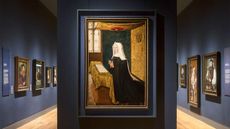People Power: Fighting For Peace
A new exhibition at the Imperial War Museum follows the story of the British anti-conflict movement through the decades

The Imperial War Museum was founded to record Britain's military effort during the First World War and, as it enters its centenary year, still remains as dedicated to documenting how conflict and society intersect. In its new landmark exhibition, People Power, it will trace how the anti-war movement has evolved throughout the 20th century to the modern day, bringing together rare pieces from its archives alongside important loans.
Organised chronologically, it begins with the First World War and the 1920s, bringing together the personal insights of conscientious objectors impacted by the military subscription put in place in 1916. With the advent of the Second World War, anti-war sentiment became increasingly mainstream and the display looks at some of the famous faces that stood up for the cause, including Winnie-the-Pooh creator AA Milne, who wrote a letter describing his struggles to reconcile pacifism with the rise of Hitler.
The 1950s and 1960s saw a revolution in the way people protested, and anti-war movements became intertwined with the counter culture of the time. Perhaps the most enduring symbol of any anti-war organisation is the Campaign for Nuclear Disarmament. Therefore, the largest section of the exhibition is dedicated to the Cold War, as popular artists addressed the paranoia created by the pervasive fear of nuclear apocalypse at the time. As well as the original sketches of the CND logo, flyers, badges and other pieces featuring the motif will be showcased.
Subscribe to The Week
Escape your echo chamber. Get the facts behind the news, plus analysis from multiple perspectives.

Sign up for The Week's Free Newsletters
From our morning news briefing to a weekly Good News Newsletter, get the best of The Week delivered directly to your inbox.
From our morning news briefing to a weekly Good News Newsletter, get the best of The Week delivered directly to your inbox.
In 21st-century Britain, much of the political discourse has been dominated by events in the Middle East, including the wars in Afghanistan and Iraq. A final section explores how anti-war conversations have taken place in the modern age. Among the pieces on display are banners and other items from Brian Haw's protest camp, which remained in Parliament Square from 2001 until it was ordered to move in 2011. The exhibition also includes items from Britain's largest protest, held in 2003, when more than a million people marched against conflict in Iraq. Some of the most recognisable visual cues of contemporary protest movements can also be seen. These include the blood splat posters designed by David Gentleman for the Stop the War Coalition and placards from the Stop Trident demonstrations last year.
People Power: Fighting for Peace is at the IWM London from 23 March to 28 August, tickets £10; iwm.org.uk
Create an account with the same email registered to your subscription to unlock access.
Sign up for Today's Best Articles in your inbox
A free daily email with the biggest news stories of the day – and the best features from TheWeek.com
-
 'Voters know Biden and Trump all too well'
'Voters know Biden and Trump all too well'Instant Opinion Opinion, comment and editorials of the day
By Harold Maass, The Week US Published
-
 Is the Gaza war tearing US university campuses apart?
Is the Gaza war tearing US university campuses apart?Today's Big Question Protests at Columbia University, other institutions, pit free speech against student safety
By Joel Mathis, The Week US Published
-
 DOJ settles with Nassar victims for $138M
DOJ settles with Nassar victims for $138MSpeed Read The settlement includes 139 sexual abuse victims of the former USA Gymnastics doctor
By Justin Klawans, The Week US Published
-
 Death Cafes: where people talk mortality over tea and cake
Death Cafes: where people talk mortality over tea and cakeWhy everyone's talking about The meet-ups are intended to offer a judgement-free and respectful space to discuss the end of life
By Chas Newkey-Burden, The Week UK Published
-
 10 museum exhibitions to see this winter
10 museum exhibitions to see this winterThe Week Recommends The Roman Empire, Ukrainian modernism and early Buddhist art are all covered
By Catherine Garcia, The Week US Published
-
 Da Terra review: high-end elaborate dining in London’s East End
Da Terra review: high-end elaborate dining in London’s East EndThe Week Recommends Each dish at this two-Michelin-starred restaurant requires evident toil, but the resulting flavours appear effortless
By Arion McNicoll Published
-
 TikTok chef Thomas Straker sparks hospitality diversity row
TikTok chef Thomas Straker sparks hospitality diversity rowSpeed Read Restaurant owner apologises after fierce criticism of pictures showing his all white male kitchen team
By Julia O'Driscoll Published
-
 The cost of clean air: who will win the battle over low emissions zones?
The cost of clean air: who will win the battle over low emissions zones?Today's Big Question Debate has ‘turned toxic’ as legal challenge to expansion of London’s Ulez is heard
By Chas Newkey-Burden Published
-
 National Portrait Gallery: the reopening review
National Portrait Gallery: the reopening reviewThe Week Recommends After a £41m renovation the gallery has reopened its doors and the result is a triumph
By The Week Staff Published
-
 Cavo London review: rooftop dining at the Outernet
Cavo London review: rooftop dining at the OuternetThe Week Recommends West End’s new entertainment development has a Mediterranean-inspired eyrie
By Alexandra Zagalsky Published
-
 Ormer Mayfair by Sofian review: a tasting menu worth overstaying for
Ormer Mayfair by Sofian review: a tasting menu worth overstaying forThe Week Recommends You’ll need to be dragged away from Sofian Msetfi’s exceptional dishes
By Dominic Kocur Published